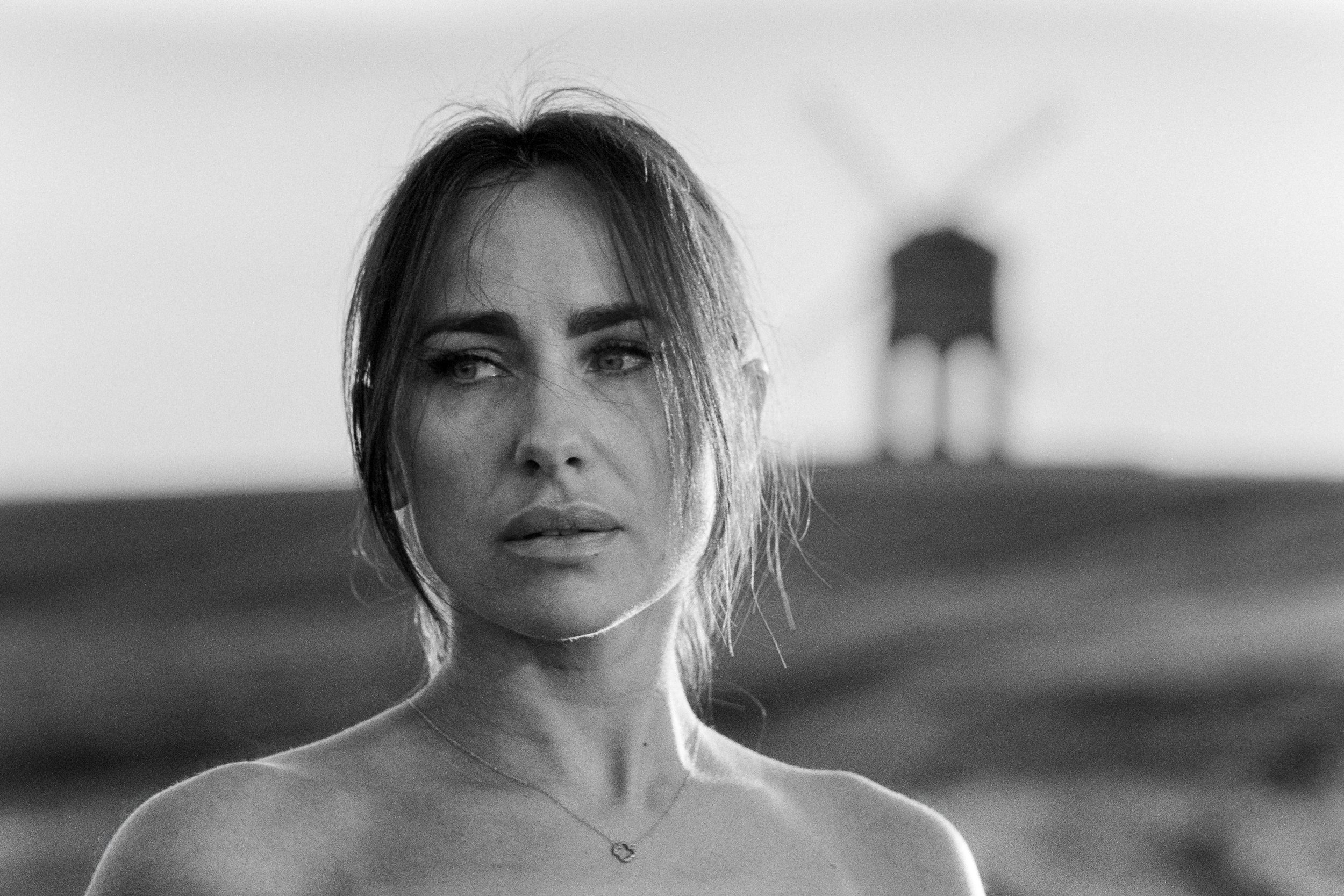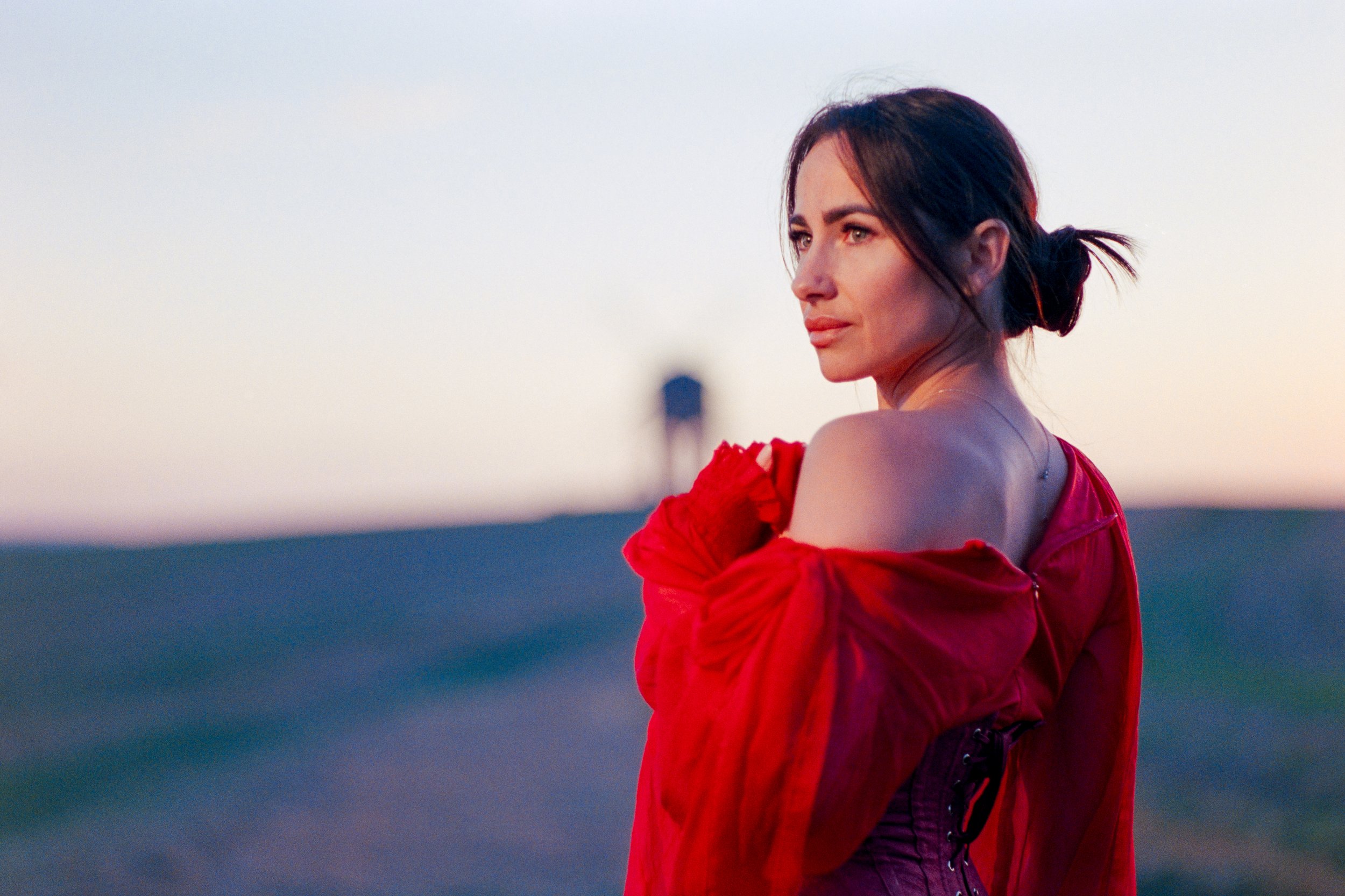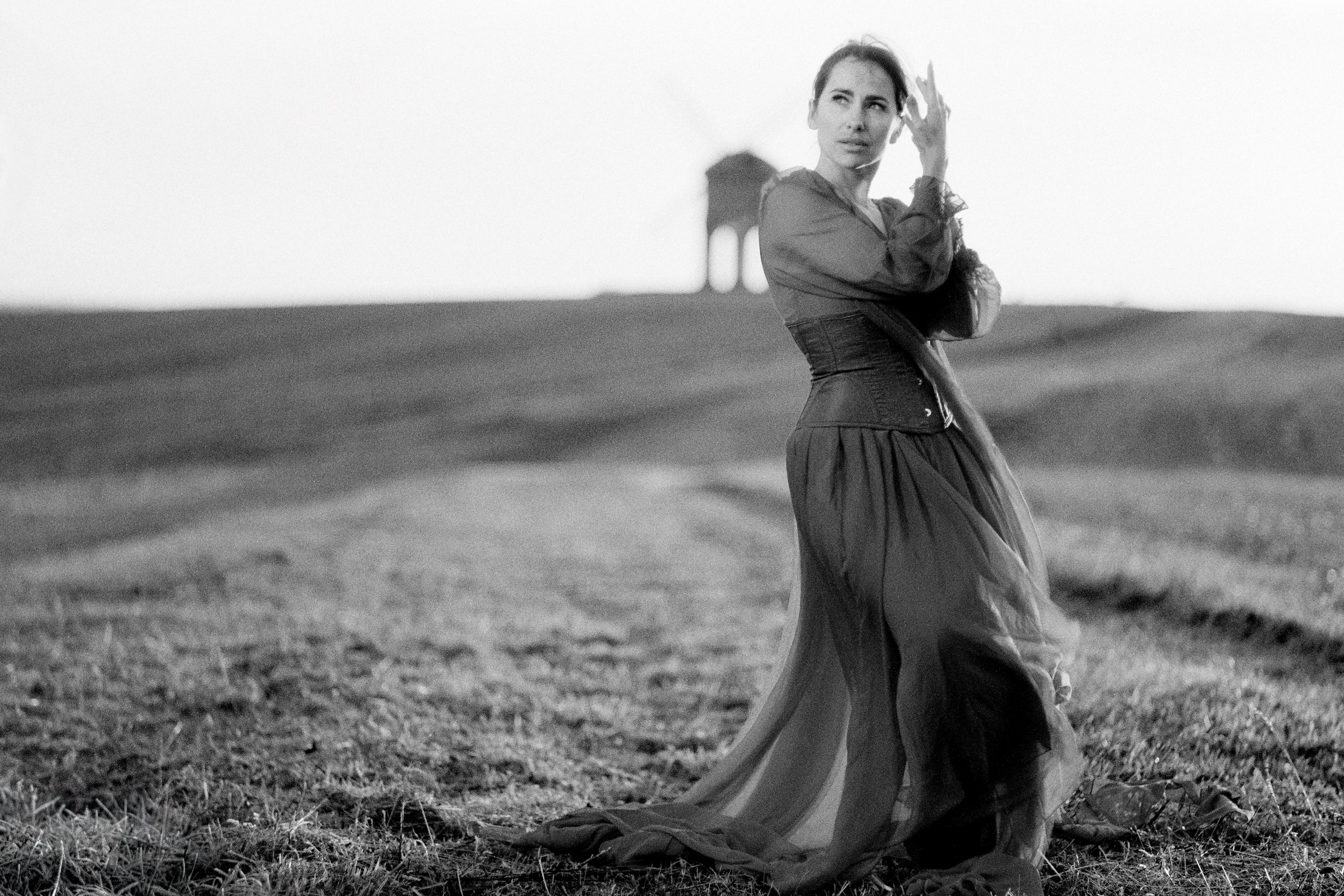Cinematic Portraits on Film – Chesterton Windmill, Leamington Spa, Warwickshire, West Midlands
Chesterton Windmill is a setting that behaves almost like a stage. It stands alone above Leamington Spa, a solitary architectural structure surrounded by uninterrupted landscape, and this isolation gives it a rare cinematic profile. For portrait photographers working across Warwickshire, the West Midlands and the Cotswolds, it is one of the few local landmarks that retains a sense of timelessness — and at sunset, it becomes even more atmospheric. For this portrait session with Olga, the rhythm of the falling sun controlled everything. Forty-five minutes from start to finish meant two rolls of film, no resets, no time to revise angles, and no spare exposures. Everything had to be prepared, executed and adapted fast.
An early frame from the session, shot on Rollei RPX 100 in 510 Pyro, with the windmill brought forward in the image by the long focal length.
Lens Rendering and Cinematic Compression
The Asahi Takumar 85 mm f/1.8 and 135 mm f/2.5 lenses define the structure of these images. Both lenses share the classic Takumar signature: a smooth, cohesive rendering with pronounced midtone clarity and subtle microcontrast. When stopped down to f/5.6, f/8 and f/11, the 85 mm gives facial definition without harshness, making it ideal for controlled chiaroscuro lighting. The 135 mm increases separation and compression, and this is essential when working at Chesterton Windmill.
Long focal lengths narrow the angle of view. They reduce the relative size difference between foreground and background elements. In practical terms:
the windmill, although physically distant, is pulled visually forward
— it becomes part of Olga’s presence rather than a distant object.
This is a deliberate aesthetic choice. It blends portraiture and landscape into a unified cinematic frame, echoing the compositional techniques used by mid-century cinematographers when merging character and environment into a single emotional space.
Lighting: Controlled Chiaroscuro Under a Moving Sun
The Hobolite with a Bowens-adapted parabolic modifier remained at Olga’s right (viewer’s left) throughout. A parabolic light gives direction and contour without breaking the tonal cohesion — a modern continuation of classical chiaroscuro lighting (light–dark modelling used in European portraiture and in cinema from the 1940s through the 1970s).
Chiaroscuro shaping in fast-changing light: a directional Hobolite edge illuminates the face while the long focal length brings the windmill into the frame.
This lighting approach comes directly from the cinematographers whose influence naturally threads into my work:
Sven Nykvist (Bergman) for the clarity of light on skin, the gentle separation of highlight and shadow.
Gunnar Fischer for the poetic interplay of wind, hair, shadow and horizon in outdoor portraits.
Raoul Coutard for blending ambient light and directional light to create fluid transitions as day fades.
Néstor Almendros for simplicity: one light, carefully placed, allowed to breathe with the landscape.
Their influence appears in the way I sculpt the light rather than dominate it. The modifier is not there to overpower the sun; it is there to maintain structure as natural light collapses.
Why Film Works Differently at Sunset
Sunset is one of the few lighting conditions where film and digital behave in fundamentally different ways, not because of nostalgia or sentiment, but because of how film emulsions interpret falling light. When the sun drops and colour temperature shifts minute by minute, film begins to reveal characteristics that are built into the chemistry itself.
The first difference is the shape of the film’s exposure curve. Film does not respond to light linearly. Its highlight rolloff is gradual, elastic, and forgiving, which means the last trace of sunlight can stretch further across the frame before collapsing into overexposure. Where digital clips abruptly, film tapers gently. This matters at sunset because the brightest parts of the sky often sit right on the edge of exposure. Film keeps the shape of those highlights intact, giving the sky tone, separation and nuance even as the sun drops behind the horizon.
The second difference is how film handles low, warm light. As the sun reaches the horizon, the colour temperature drops into the warm spectrum, but film does not shift into exaggerated reds. Colour negative film — especially motion-picture-derived stocks like Candido 800 — interprets warm light as depth rather than heat. Skin tones stay natural, the environment gains atmosphere, and the colours settle into a cinematic palette that feels controlled rather than forced. This behaviour is part of why late-sun portraits on film look cohesive even when the light is falling quickly.
Third, film’s dynamic range sits where sunset actually happens. The contrast between the illuminated sky and the shaded landscape increases rapidly in the final half hour of daylight. Film holds both sides of this range — bright sky and deep shadow — without flattening the image. The shoulders of the curve protect highlight detail; the toe slows the descent into shadow. The result is a frame that feels full, dimensional and atmospheric at a moment when many digital sensors struggle.
A cinematic film portrait made at the edge of golden hour, showing how analogue colour handles the last light of the day with smooth highlight rolloff and natural skin tone. Shot in Leamington Spa on Candido 800, cross-processed in ECN-2.
There is also the matter of grain interacting with diminishing light. Grain does not appear in low light as noise does. Instead, it maintains structure. It becomes part of the atmospheric texture of the scene. At sunset — especially with RPX 100 in 510 Pyro — grain acts almost like a micro-contrast system, preserving edge definition and preventing the soft tones of dusk from turning the frame mushy or undefined. The combination of grain structure and pyro stain keeps the image coherent even as the ambient light weakens.
Finally, film has a unique relationship with the transition into blue hour. As the sun falls below the horizon, the colour spectrum cools. Digital sensors often swing abruptly into blue-magenta territory at this moment, requiring correction. Film does not. Motion-picture stocks are engineered to stabilise colour transitions across changing light, and ECN-2 processing reinforces this behaviour. The shift from golden hour to blue hour becomes smooth, organic, almost invisible. Skin tones remain believable; the sky settles into gradients rather than blocks of colour.
At sunset, film does not simply record what is present — it interprets it. Its response to warmth, highlight density, shadow depth and falling ambient light aligns naturally with the emotional and visual qualities we associate with cinema. This is why film portraits made at the edge of daylight feel atmospheric, cohesive and timeless: the medium itself is shaped for this moment.
The Race Between Golden Hour and Blue Hour
Golden hour at this location lasts minutes, not an hour. As the sun drops, three things happen quickly:
Contrast decreases
Colour temperature rises, then cools sharply
Shadow mobility increases as the ambient collapses
The images show this transition clearly. The earliest frames have the warm wrap of low-angle light; the mid-sequence frames move toward cooler greys; the final colour frames fall into the blue-hour palette where Candido 800 film excels.
I was metering constantly with the Sekonic because the exposure value was dropping every two to three minutes. This is the type of session where precision matters: too little attention and you lose the light, too much rigidity and you miss the moment. The light wasn’t controlled — it was negotiated with.
Model Communication and Rapport Under Time Constraints
A blue-hour moment shaped through close communication — subtle direction, quick adjustments and shared timing as the last light faded.
With the light changing this fast, communication became central. To achieve consistency across the two rolls, I’m having real-time discussions with Olga so that she gets the best photographs possible:
Explained how rapidly the light was shifting
Asked Olga to hold still while I refine the parabolic edge over her face and body
Directed her attention toward or away from the light depending on the shot’s mood
Guided subtle adjustments of chin, eyes, and shoulder position
Called out when the wind rose or the light dipped
Described what I was seeing through the viewfinder (“Hold that — the highlight on your cheek just opened up”)
Talked her through each adjustment “We have seconds — stay with me. Move slightly left. Hold. Breathe.”
Rapport in film portraiture is not soft or vague; it is functional. It builds trust so the model can respond instantly when time is scarce. These images show trust — the slight movements, the shifts of expression, the balance between poise and natural presence. That is what clients feel when they look at portraits like this: the collaboration is visible even if they don’t consciously read it.
510 Pyro and the Interpretation of RPX 100
RPX 100 in 510 Pyro gives long, smooth tonal transitions and controlled highlights — ideal for directional light and fast-changing conditions at the windmill.
510 Pyro remains one of the finest developers for fine-grain black-and-white portraiture. The staining action provides:
a long, smooth tonal curve
preserved highlights even when the subject is lit directionally
local contrast without harshness
tighter grain and more dimensionality
Pyro negatives from this session will have:
olive-yellow stain in the highlights
rich mid-tones
a very gradual transition between lit and shaded areas
a stability that scans beautifully without forced corrections
This is why the black-and-white images feel controlled despite the wind and the time pressure — the developer supports the lighting choices rather than fighting them.
Candido 800 in ECN-2: Cinema Colour Without Compromise
Candido 800 is almost certainly a cinema stock repackaged for still photography. It behaves far too gracefully in the highlights and too consistently in the shadows to be generic C-41. Its colour response, dynamic range and grain pattern resemble a Vision3 lineage.
A blue-hour portrait on Candido 800 developed in ECN-2, showing the smooth gradients, controlled reds and natural skin tones that cinema chemistry preserves.
When processed in ECN-2 instead of C-41:
contrast softens
saturation becomes cinematic
shadows open slightly
highlight transitions smooth out
grain becomes uniform and fine
Because Candido is sold without remjet, you can run it directly through ECN-2 with no pre-bath. That alone marks it as cinema film converted for consumer or experimental use.
In blue-hour portraiture, ECN-2 brings enormous benefits:
skin tones remain natural rather than drifting into magenta
the red garment stays luminous rather than blocking
the cool sky retains gradient instead of flattening
This is why the final colour frames have a cinematic glow — they are not trying to look cinematic; they are produced with the same chemistry that cinema relies on.
The Outcome: A Flagship Portrait Session for Local Clients and Film Photographers
This session represents the core of what I offer as a portrait photographer in Leamington Spa, Warwickshire, the West Midlands and the Cotswolds:
Full analogue workflow
High-end optics with proven cinematic history
Controlled, directional lighting designed for portraits that age beautifully
Precision metering under fast-changing conditions
Rapid communication and rapport with the model
Expert development in 510 Pyro and ECN-2
Aesthetic and technical continuity across the full process
A late-sun frame as the ambient light fell — the long focal length brings the windmill forward while the last moments of contrast shape the dress and movement.
For potential portrait clients, these images show what is possible when craft, experience and timing align. For film photographers, the session demonstrates how optics, chemistry, technique and communication merge to produce frames that feel cinematic, sculpted, and intentional.
This is film portraiture at its highest level — precise, atmospheric and permanent. If you want portraits made with this level of craft, using real film, controlled lighting and a fully hand-made workflow, you can book a session with me in Leamington Spa, Warwickshire, the West Midlands or the Cotswolds.
All images in this article were developed and scanned in-house and UK-wide lab at Liquid Light Lab, our dedicated 35 mm film development and studio based in Leamington Spa. Send in your film and you’ll get exceptional results, up to 60MP TIFF and JPEG scans, and rare pyrogallol for exceptional black and white images.
By Martin Brown | Liquid Light Whisperer








